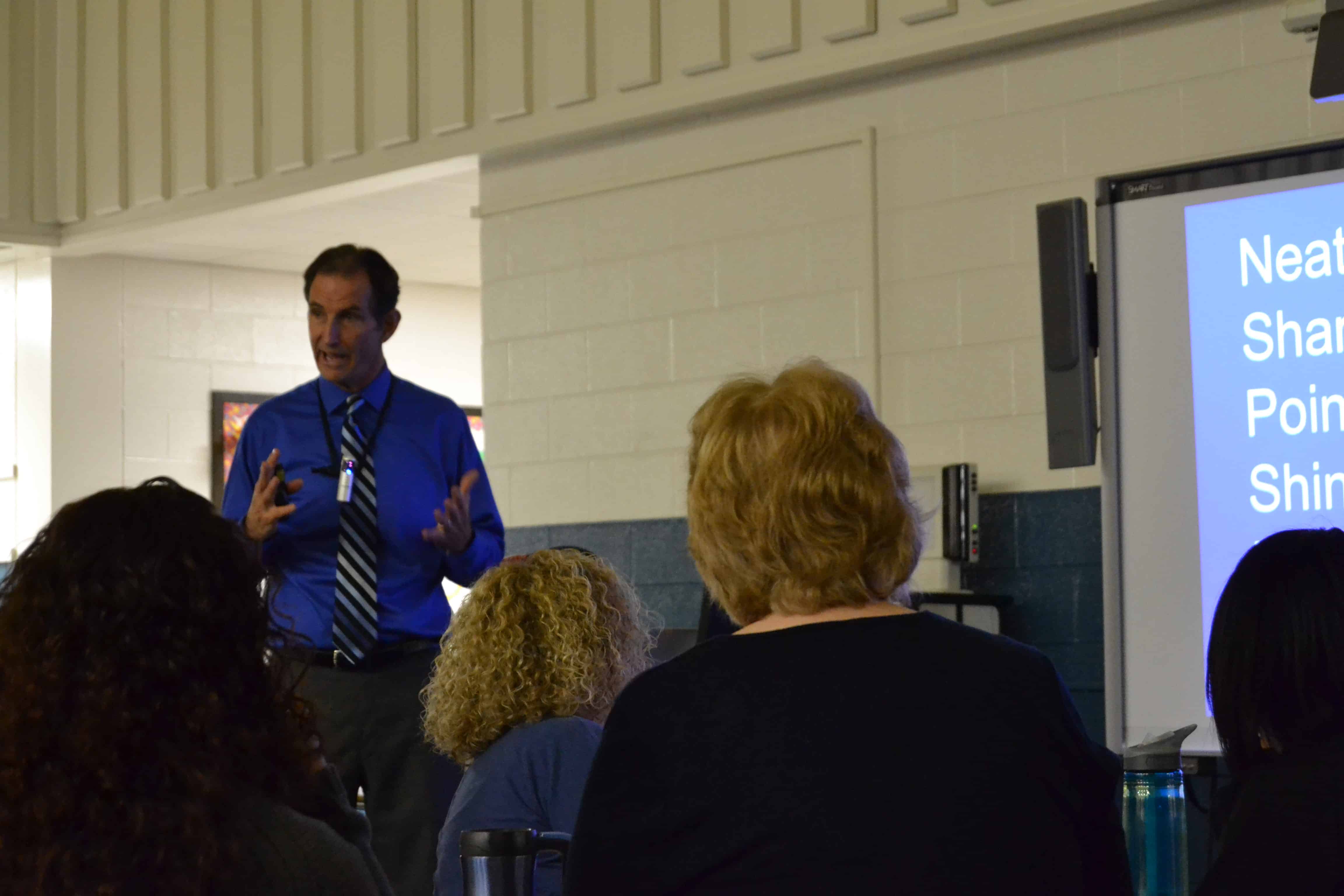Every morning, Eric Jensen reads a self-written paragraph about his life out loud. He reads that he spends time with his loving wife. That he works out. That he makes a difference with his job.
Jensen, best-selling author and education leader, believes in the power of creating narratives. In a school environment, stress is everywhere — especially when students grow up in poverty. On Monday, he encouraged the K-2 staff of Hall-Woodward Elementary School to own their stress and to control the narrative in their minds.
Hall-Woodward is a low-performing Winston-Salem school whose entire student population lives in poverty. In the past year, principal Celena Tribby said the school has gone from an F to a D letter grade and, this year, met the state’s growth standards. The majority of Hall-Woodward students are Hispanic, and many students’ families move a lot. Just on Monday, four new students enrolled at the school.
“Don’t point out kids as the reason for your stress,” Jensen said to a library full of teachers of all subjects. “You stress you out.” Jensen suggested teachers should expect 70 interruptions each school day — that they should include that in their mental narratives. When a student acts out, or an angry parent calls, or something goes wrong, it’s like checking off boxes on a to-do list instead of feeling thrown off track. On one of the first slides in Jensen’s presentation titled “Bottom Line,” he wrote: “Students can change if you change first.”
This kind of introspection, responsibility, and attention to emotional states was threaded throughout Jensen’s training. When talking about how to produce change throughout a school, he started with how to change individually. He boiled down big topics, like the teacher shortage, to where each of those teachers are mentally and emotionally.
The average teacher, Jensen said, carries both the successes and failures of their students with them at all times. If things aren’t going well in the classroom, they often feel failure, which turns into guilt and eventually shame. “That shame is deadly,” Jensen said.
“You have to be so…in their life, in their heart, in their face, to get them out of that stuck territory,” Jensen said. That’s what school leadership is for.
It’s the same with students — emotional and mental needs come first, he said. Jensen started off explaining how students who live in poverty are often under chronic stress, which can impact memory, IQ, coping capability, and behavior. This stress doesn’t come in waves and then allow a return to homeostasis, Jensen explained. It often leads to allostasis: a “re-set in our brain’s thermostat.” Some students, Jensen said, have inadequate responses. Because of intense and prolonged stress, they shut down and don’t care.
Others have prolonged responses. These students try to maintain control of things and are often on edge: they stand their ground, talk back, and aren’t scared of consequences that might work for their peers.
Jensen was one of the latter. He remembers using foul language or misbehaving and laughing when he was sent to the principal’s office. Because of his own background, he didn’t know how to behave or respond appropriately.
Jensen said parents and teachers often think children will either develop emotions naturally or pick them up throughout life. “No,” he said. “They won’t.” So, Jensen said, teachers can help. The hard-wired emotions — ones that are usually found in every person, regardless of circumstance — include sadness, joy, disgust, anger, and fear. But emotions like humility, forgiveness, sympathy, gratitude, and compassion are all taught.
Jensen shared strategies for teachers to help change the mental and emotional capabilities of poor students. They were based around four areas: cognitive capacity, behavior, attitude, and effort.
Jensen stressed that IQ and cognitive ability aren’t set in stone. There are exercises that, over time, will show results. For example, children’s working memory — which requires not only retrieving information but also manipulating it — can be improved if made a priority in the classroom.
One memory game Jensen shared went like this:
Have students get in pairs. One student will say a set of numbers on the board. The other, facing the opposite direction, has to repeat the numbers in reverse order and then say them in order. Hall-Woodward teachers tried. I tried. As the number sets got larger and more scrambled, it wasn’t easy. The same activity could use letters instead, requiring students to spell three different words with a set of five letters.
In altering the attitude of students, expectations matter. Jensen said both students’ expectations for themselves and teachers’ expectations for students could be the difference-maker in whether a student achieves. First, Jensen said, they must feel like they can — like they belong, can make progress, and can go places.
“Those things, to a middle-class white person sound so trivial,” Jensen said. “Like, what’s the big deal? But if you grow up poor, and particularly a kid of color, what runs through your head are a lot of those things like, ‘Am I good enough? Do I belong here? Can I make it?'”
He said teachers must raise the bar and set big goals for their students, and expect them to succeed.
“It’s gotta be: I will not let you fail,” he said. “You simply won’t fail under my watch.”
Feedback is also important, Jensen said. He suggested “S-E-A” feedback, which means telling students when they used an effective strategy, validating their effort in completing a task, and acknowledging a positive, growth-centered attitude. Jensen also said that using attribution is greatly important. He told teachers to get rid of the phrase, “Good job.” Most of the time, that doesn’t mean anything to students. Instead, attribute a cause and effect to the situation. Tell the student that because she used multiple strategies to figure out the math problem, she finally got the right answer. Adding attribution to student feedback has an effect size of 1.42 — or over two years of progress.


Tribby said multiple teachers approached her and thanked her for bringing Jensen to the school. Over the last year, the Hall-Woodward staff read Jensen’s book, Teaching with Poverty in Mind, and plan to move to his Engaging Students with Poverty in Mind next. The Winston-Salem Foundation’s Peer Project paid for Jensen’s workshop. Tribby said the opportunity is giving teachers ideas for how they can take what they’re already doing and “bump it up a notch.”
“It’s giving them those strategies that they can implement in the next 24 or 48 hours,” Tribby said.
Liz Roach, a second-grade Hall-Woodward teacher, said she plans to try out the return-to-class rituals Jensen shared with the group. These can be as simple as having students turn to each other and say, “Welcome back!” after a break and get students used to focusing again.
Adults often misattribute symptoms of impulsivity or a lack of focus to ADHD. Jensen emphasized that this is often not the case. Roach said she’s now able to understand some of her students’ behavior after learning about chronic stress from poverty.
“When he was talking about the chronic stress, I immediately honed in on at least three of my students,” Roach said. “Now that I have that knowledge, I can address it differently.”





